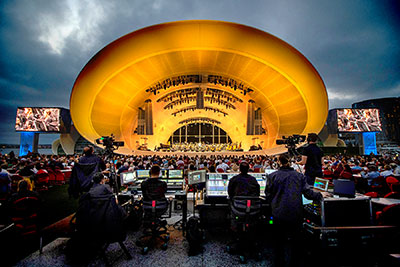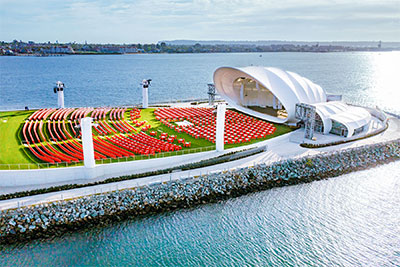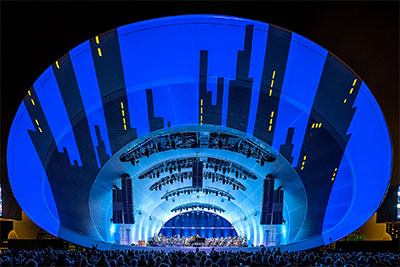The new outdoor home to the San Diego Symphony, Rady Shell at Jacobs Park is an architectural wonder on the edge of San Diego Bay and in the heart of the city’s downtown. Designed to complement the sails of the nearby San Diego Convention Center, the US$85m concert shell is wrapped in a translucent flexible material that covers the performance space. Depending on the event, audience capacities and set-ups range from intimate two/four-person table seating arrangements to standing crowds of up to 10,000.
As an outdoor symphonic performance space, The Shell counts a PA system as part of its infrastructure, with three DiGiCo mixing consoles – a Quantum 7 FOH mix desk, with a SD10 for monitor mixing and an SD12 for auxiliary mix and processing. The three consoles, three SD-Racks located on stage, and a Mini-Rack in the amp room are all on a dual Optocore network, with the entire system designed and integrated by Solotech.

‘There are several reasons why we chose the DiGiCo consoles, and they are all areas that the brand excels in,’ says Solotech Business Development Manager and Senior Engineer, Aaron Beck. ‘First, there’s capacity – the Quantum7 can run 200-plus inputs. Then there’s the Quantum processing power.’ Becks cites features like Quantum’s Mustard Processing channel strips, Spice Rack plug-in native FPGA processing options, and Nodal Processing all as standout features. ‘Plus, there’s the overall quality of the sound, which is exceptional.’
The Shell will host touring groups each year, many of whom will bring their own audio engineers and all of whom will be familiar with DiGiCo console architecture and operation. That familiarity will be important for more than just operational reasons. Jacobs Park is located within a major metropolitan area that, like many, has stringent noise regulations. San Diego has deployed NTi Audio noise measurement devices nearby that automatically issue reports via cellular data to key elements of the city’s environmental control, as well as directly to the house engineer at Rady Shell.
‘The venue’s engineer can adjust the overall volume of the entire system from the FOH console when necessary to keep every show within compliance,’ Beck says.
Founded in 1910, the San Diego Symphony is the oldest orchestra in California and one of the largest and most significant cultural organizations in San Diego, and performs for more than 250,000 people each season, offering a wide variety of programming.
Joel Watts, the Symphony’s Audio Director, says the way the three DiGiCo consoles are networked on their own Optocore loop, along with a BroaMan Route66 Optocore AutoRouter, makes the entire console infrastructure effectively modular. ‘A single orchestral show here is 90 inputs, so being able to use all of the consoles, if necessary, as a single system is extremely helpful and efficient,’ he says. ‘And console features like Snapshot really add to that. It lets us manage a large number of inputs easily.’
Watts further notes that the 32-bit Ultimate Stadius microphone preamps on the SD-Racks are the next best thing to the kinds of high-end mic preamps he’d choose in the studio for recording classical orchestras. ‘My background is in studio production, and we’re recording most of the performances here for later postproduction, and the DiGiCo mic preamps sound fantastic,’ he says. ‘We’re also doing all of our television streaming of concerts through them, too. No coloration, fully transparent – that’s what you want for classical music. It makes it sound like a CD. You couldn’t ask for more from a console in this kind of situation.’
On the PA...
The venue’s loudspeaker PA is an immersive L-Acoustics loudspeaker configuration designed in Soundvision by Françcois ‘Frankie’ Desjardins of Solotech. Working in tandem with sound consultant Shawn Murphy, Solotech integrated the venue’s full AVL system.
‘It does look as good as it sounds,’ says Beck. ‘The white exterior wrapping material is a kind of plastic cloth and the interior is covered with a white scrim material. L-Acoustics was able to provide an entire K2 system in white, as well, to match it. It’s only the second one like it; the other is the Hollywood Bowl. The way it all works together visually is quite wonderful.’

The system comprises two main arrays of 16 L-Acoustics K2 per side, flanked by two hangs of eight cardioid-configured KS28 subs per side and a centre array of nine K2. Another 16 KS28, also in cardioid configuration, are located underneath the stage.
In addition, six towers comprise the surround elements of the 7.1-type system design – two side-surround towers per side hold four A15 Focus speakers each, with the rearmost tower on each side also holding six Kara II with mechanically adjustable HF-steering fins. Two rear-surround towers are fitted with four Kiva II and two SB15m subs each. The system is powered by two dozen LA12X amplified controllers, with system processing by L-Acoustics’ LA Network Manager.
While it’s designed to project the orchestra across the wide span of the open-air venue, this system will also offer Rady Shell and the San Diego Symphony a highly flexible venue that will easily accommodate a wide range of visiting artists. It will also give the orchestra the impact it desires when performing live scores from movies shown at the park. Beck says the immersive design of the system reflects the growing demand by touring artists for that type of sound – and the L-Acoustics system at Rady Shell does just that – cost-effectively.
‘One way we’re achieving that sense of immersion is by taking some of the reverb returns from the front-of-house console and sending them to the surround speakers, which really enhances the immersive effect,’ he explains.
Beck also notes that the large number of subwoofers has less to do with impact than with directionality, always a difficult goal to achieve with low frequencies. ‘It’s not so much about output as it is about control of the low frequencies,’ he says. ‘There are very strict noise-control measures in place here and on nearby Coronado Island, and the KS28 subs in the cardioid configuration give us tremendous ability to steer that energy where we want it to be and away from where we don’t want it.’
The same, he says, goes for the K2 Panflex horizontal steering technology, which combines mechanically adjustable fins with DSP algorithms effective from 300Hz. ‘It’s all about putting the sound on the seats and keeping it from escaping the venue,’ Beck elaborates. ‘K2 gives us not only excellent sound quality but also the tools we need to stay in compliance with local noise ordinances. Soundvision was incredibly helpful for that.’
San Diego Symphony Audio Director Joel Watts says that this system is particularly effective for amplifying a symphony orchestra in an outdoor environment. ‘In a space like this, where the seating goes back a full 200ft, the only way to fill it with acoustical music, is with amplification. But it has to be done in such a way that everyone hears only the music, never the speakers. And that’s especially true of a surround system like this. If you truly hear the surround speakers, then they’re too loud. These are the only speakers that can achieve this. You hear only the music, not the system. And it sounds marvellous.’
 Watts also points out that the asymmetric configuration and precise placements of the speakers allow the orchestra to achieve full impact without exceeding the noise restrictions: ‘We have full dispersion to one side of the system and virtually none to the other side, thanks to the fins on the K2,’ he says. ‘It focuses the sound and keeps it on the seats. It never crosses the lease line.’
Watts also points out that the asymmetric configuration and precise placements of the speakers allow the orchestra to achieve full impact without exceeding the noise restrictions: ‘We have full dispersion to one side of the system and virtually none to the other side, thanks to the fins on the K2,’ he says. ‘It focuses the sound and keeps it on the seats. It never crosses the lease line.’
In addition to allowing the venue to achieve the rare goal of properly amplifying a symphony orchestra, the L-Acoustics system also makes the venue fully rider-ready. ‘We need to keep labour and time costs to a minimum, so we hope no one needs to bring in a PA; everyone should be happy using ours,’ he says. ‘And ours is often the same one they’ll carry anyway. That’s why we chose L-Acoustics.’
Finally, says Beck, K2 and the other speakers that make up the system are all able to withstand the kind of weather they will face since they’re right next to the ocean. ‘Having the venue be so close to saltwater can be pretty harsh on sound components, and the temperature swings here can also be dramatic at times,’ he says. ‘But the L-Acoustics speakers handle that very, very well. Combine that with how rider-friendly they are, and you easily see how they were the perfect choice for this project.’
More: www.solotech.com